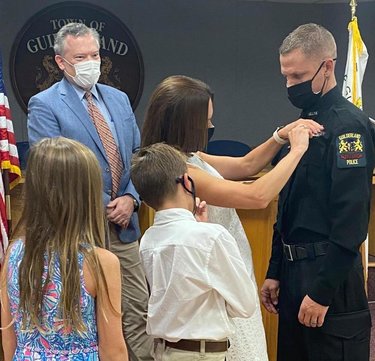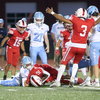SRO about ‘about prevention and building relationships’ says GCSD super
GUILDERLAND — The school board here approved its first contract for a school resource officer although it has had a series of officers since the end of the last century.
Officers were originally posted in both Guilderland High School and Farnsworth Middle School although budget cuts caused the district to reduce those two posts to one, shared throughout the district.
A written agreement is required by the district’s safety plan, Superintendent Marie Wiles said at an earlier meeting. The town pays the officer’s salary for the year and the school district then pays the town for the 180 days that the officer is in the schools.
Before voting to approve the nine-page memorandum of agreement on March 8, board member Rebecca Butterfield asked for data on the SRO, saying she would like to know what he does on a daily basis and what actions have been taken on criminal matters.
Wiles responded that such information could be gathered and said, “None of us can remember … a single incident where a student was arrested.”
Over the years, The Enterprise has covered a number of student arrests made by the school resource officers. In 2000, a 12-year-old Farnsworth student was arrested after writing the words “Bomb! at 1:00” on the wall in the boys’ bathroom, police said. He was charged with falsely reporting an incident in the first degree, a felony.
Two years later, two other Farnsworth students, ages 11 and 13, were arrested on felony charges, in separate incidents, for writing bomb threats on school property. Both juveniles were charged with first-degree reporting an incident, a felony; and with making graffiti, a misdemeanor.
At the high school, students Garrett Barmore and Andrew Dillon were arrested in 2003. Both African-American seniors, they fought in the school cafeteria, police said, with a white student who had called them “nigger.” They were each charged with disorderly conduct, a violation, and third-degree assault, a misdemeanor. The white student, Jordan Peceri, was not charged in the incident.
In 2005, one 15-year-old boy stabbed another 15-year-old boy in the back with a piece of jewelry shaped like a Christian cross. Two-and-a-half inches of the four- or five-inch cross broke off in the victim’s back, the school resource officer at the time said; the stabbing was over a disagreement about a girl, he said. The student accused of the stabbing was charged with second-degree assault, a felony. Both of the students were white.
Wiles told the school board on March 8 that there have been illegal substances in the schools and that the school resource officer assists with “collecting those and taking those off our hands.”
“But the whole goal really is more about prevention and building relationships,” Wiles said.
“The mission of the SRO Program is to promote school safety by building a positive school climate in which everyone feels safe and students are supported to succeed,” says the memorandum. “The SRO Program also seeks to reduce violent crime committed by and against youth in our community.”
The memo also says, “SROs are responsible for the majority of law enforcement activities occurring at the school during school hours but not general student discipline. A determination of whether an activity raises to the level of a law enforcement activity shall be made in consultation with a school administrator.”
The memo lists three general criteria for school resource offices: college or degree coursework, experience as a police officer and commitment to student well-being, and proven performance free of significant disciplinary action.
On responding to criminal activity, the memo says, “As a police officer, SROs have the authority to issue warnings, make arrests and use alternatives to arrest at their discretion. SROs, however, perform their duties mindful of the parties’ common goal of supporting student success.”
On searches, the memo says, “SROs may participate in a search of a student’s person, possessions, locker, or vehicle only where there is probable cause to believe that the search will turn up evidence that the student has committed, is committing, or is about to commit a criminal offense.”
On arrests, the memo says, “Incidents involving public order offenses, including disorderly conduct, profanity, and fighting that do not involve serious physical injury or a weapon, should be considered school discipline issues to be handled by school officials rather than criminal law issues warranting formal law enforcement intervention.”
At the start of the March 8 meeting, school board President Seema Rivera read two letters — one from a parent and the other from a student — both advocating for more resource officers.
Brian Sheridan, a pediatrician who ran a close race for Guilderland Town Board on the Republican ticket in November, supported the proposal raised at an earlier school board meeting by three students, to require education on safe gun storage.
“A bigger problem facing schools is figuring out why a child decides to take a gun and use it,” Sheridan wrote. “Usually, school bullying is to blame …. It is with regret that I make the suggestion that school bullying is not being dealt with appropriately by schools, pediatricians, and other community programs. DASA reports are frequently not done at Guilderland Schools,” he wrote of the state’s Dignity for All Students Act.
Sheridan said school resource officers are knowledgeable about both of those topics as well as others, like drug prevention and investigation, and advocated hiring at least two officers.
Ariana Roopnarine praised Sean Ralston, Guilderland’s current school resource officer. “Officer Ralston connects and bonds with the students and by doing it, it allows students to trust him and talk to him about anything,” she wrote.
Roopnarine went on, “I was going through a situation with a teacher and he was the first one I told and he helped and reassured me that I’ll be okay, safe … He actually helped in a way that was looking out for me rather than trying to keep the teacher out of trouble.”
She went on, “We are currently dealing with cyber bullying throughout all grades and Officer Ralston is trying his hardest to take control of it and stop it.”
Roopnarine concluded that having more than one officer would help in other schools.



